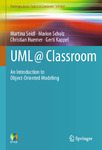| dc.description.abstract | The challenges in today’s software development are diverse and go
far beyond implementation tasks. They range from requirement specification
over system design and implementation to maintenance and
further adaptation of the software—to name just a few phases in the
software life cycle. In all of these phases of the software development
process, many people with different backgrounds and experiences
are usually involved. These people need a common language for efficient
communication. Obviously, such a language should be as precise
as possible without the ambiguities of a natural language. For this
purpose, modeling languages have emerged. They are used to create
sketches and blueprints for software systems, which in turn serve as
a basis for the implementation or even automatic generation of executable
code. In the area of object-oriented software development, the
Unified Modeling Language (UML) was able to prevail. Of course, to
use the language correctly and efficiently, it is necessary to understand
the concepts offered by UML. Since 2006, we have offered the course
“Object-Oriented Modeling” at the Vienna University of Technology.
This course is mandatory for computer science and business informatics
students in their first year. Overall, we have up to 1,000 students per
year who attend our course. To deal with such a huge number of students
while keeping high quality standards, much effort has been spent
on the preparation of such a course. This includes the overall organization,
course material, and e-learning support. Parts of the course design
have been presented at the Educators’ Symposium of the MODELS
conference [8, 9, 10, 11, 7, 46]. We teach the basics of object-oriented
modeling by means of UML. | en_US |

